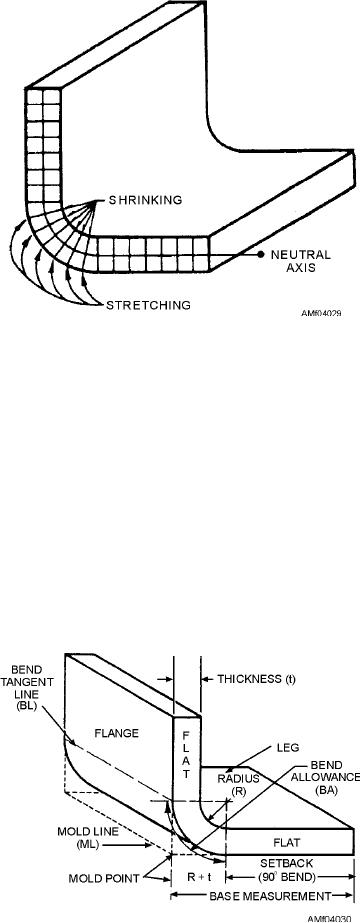
A layout fluid should be applied to the surface of
the metal so that the pattern will stand out clearly. Any
one of several approved fluids may be used. Bluing
fluid, a blue dye dissolved in alcohol, is the most
commonly used layout fluid. Since it does not protect
metal against corrosion or serve as a paint binder,
bluing fluid should be removed after use. Either
ordinary paint thinner or alcohol may be used to remove
it.
To begin the layout, you should ensure that one
edge of the metal is straight. All measurements can then
be based on the straight edge of the sheet. Lines at a
known angle or parallel to the straight edge can be
made by marking points from a combination square
held firmly against the straight edge.
If it is impossible to obtain a straight edge on a
sheet to start a layout or if the distance from the edge is
too great, a reference line may be used. The reference
line may be made by connecting any two points with a
Figure 4-29.--Neutral axis.
straight line. Perpendiculars may be erected to the
reference line by using a compass or dividers. Once the
BEND ALLOWANCE TERMS
perpendicular is accurately established, it may be used
as a basis for almost any layout.
You should be familiar with the following terms
A scriber must never be used for drawing lines on
related to a bending job. Figure 4-30 shows the meaning
aluminum or magnesium except to indicate where the
of some of these terms.
metal is to be cut or drilled. All other lines should be
Bend allowance. The amount of material
drawn with a soft-lead pencil. The pencil mark should
consumed in making a bend.
be removed from aluminum and magnesium to prevent
an electrolytic action that will eventually cause
Closed angle. An angle that is less than 90
corrosion. It can be removed with isopropyl alcohol or
degrees when measured between legs. When the
MEK. If you fold a piece of metal along a sharp line
made with a scriber, the scribed line will weaken the
metal and possibly cause it to crack along the bend. If it
does not crack at the time of bending, it is very
susceptible to cracking at a later time when failure of
the part could be dangerous.
Bend Allowance
When you are bending metal to exact dimensions,
the amount of material needed to form the bend must be
known. The term for the amount of material that is
actually used in making the bend is bend allowance.
Bending compresses the metal on the inside of the
bend and stretches the metal on the outside of the bend.
Approximately halfway between these two extremes
lies a space that neither shrinks nor stretches. This
space is known as the neutral line or neutral axis. Figure
4-29 shows the neutral axis of a bend. It is along this
Figure 4-30.--Bend allowance terms.
neutral axis that bend allowance is computed.
4-16

